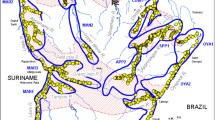Abstract
Gold was discovered in 1829 and mined until about 1940 in north Georgia, particularly within an area known as the Dahlonega mining district. The mining operations there, which involved mercury amalgamation in stamp mills and sluices, delivered significant quantities of mercury waste to streams. This paper focuses on the downstream dispersal and storage of mercury in streambank sediments of two watersheds near Dahlonega, Georgia. Mercury concentrations for individual samples of historical sediment range from 0.02 to 12.00 ppm, with average values in streambanks near the core of the mining district ranging from 0.2 to 0.6 ppm. Mercury levels rapidly decrease in the downstream direction to concentrations that are slightly above a background level of 0.04±0.02 ppm. Mercury concentrations also appear to decrease with increasing distance from streambanks. Similar levels of mercury contamination from former gold mines probably exist in many other parts of the gold-bearing rocks of the Piedmont of the eastern United States. The bioavailability and environmental hazard posed by the contaminated sediment is not certain.
Similar content being viewed by others
Author information
Authors and Affiliations
Additional information
Received: 8 January 1996 · Accepted: 29 May 1996
Rights and permissions
About this article
Cite this article
Leigh, D. Mercury-tainted overbank sediment from past gold mining in north Georgia, USA. Environmental Geology 30, 244–251 (1997). https://doi.org/10.1007/s002540050153
Issue Date:
DOI: https://doi.org/10.1007/s002540050153




